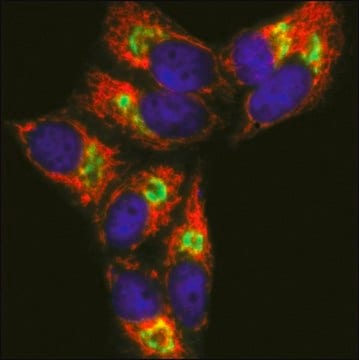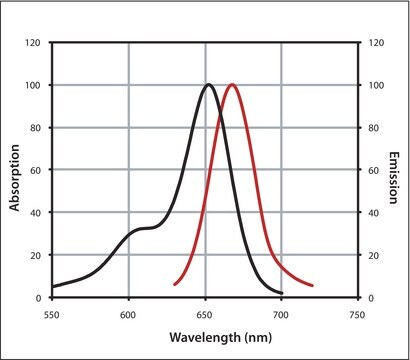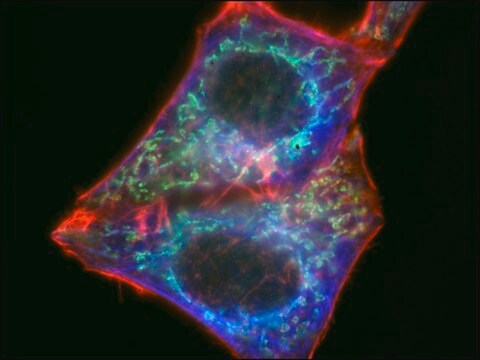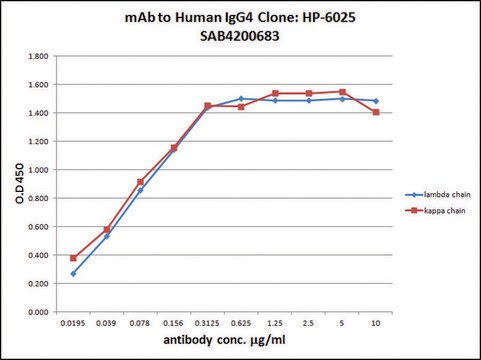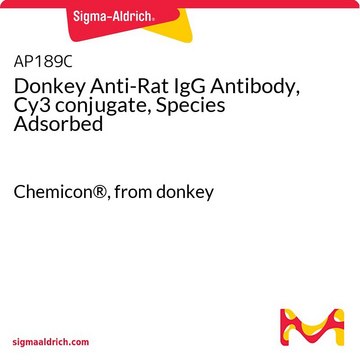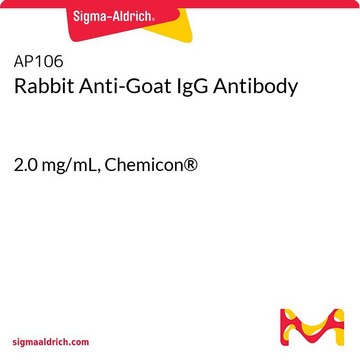AP189F
Donkey Anti-Rat IgG Antibody, FITC conjugate, Species Adsorbed
1.5 mg/mL, Chemicon®
Sign Into View Organizational & Contract Pricing
All Photos(1)
About This Item
UNSPSC Code:
12352203
eCl@ss:
32160702
NACRES:
NA.46
Recommended Products
biological source
donkey
Quality Level
conjugate
FITC conjugate
antibody form
F(ab′)2 fragment of affinity isolated antibody
antibody product type
secondary antibodies
clone
polyclonal
species reactivity
rat
manufacturer/tradename
Chemicon®
concentration
1.5 mg/mL
technique(s)
immunofluorescence: suitable
shipped in
wet ice
target post-translational modification
unmodified
Related Categories
Specificity
Antibody was isolated from whole goat antiserum by antigen affinity chromatography. Monospecific by IEP against whole rat serum. Reacts with heavy chain of Rat IgG, as well as the light chains from most rat immunoglobulin classes.
To ensure minimal cross-reactivity to non-target immunoglobulin, the antibody was solid-phase absorbed against serum proteins from bovine, chicken, goat, guinea pig, hamster (Syrian), horse, human, rabbit, and sheep.
F/P RATIO:
8.9 μg/mg; 3.3 moles FITC per mole IgG
To ensure minimal cross-reactivity to non-target immunoglobulin, the antibody was solid-phase absorbed against serum proteins from bovine, chicken, goat, guinea pig, hamster (Syrian), horse, human, rabbit, and sheep.
F/P RATIO:
8.9 μg/mg; 3.3 moles FITC per mole IgG
Immunogen
Highly purified Rat IgG isolated from pooled normal Rat Serum.
Application
1:50 - 1:200 for most applications.
Research Category
Secondary & Control Antibodies
Secondary & Control Antibodies
Research Sub Category
Secondary Antibodies Adsorbed for Dual Labeling
Secondary Antibodies Adsorbed for Dual Labeling
This Donkey anti-Rat IgG Antibody, FITC conjugate, Species Adsorbed is validated for use in IF for the detection of Donkey Rat IgG.
Physical form
Freeze-dried powder.
Storage and Stability
Store at +2-8°C. Do not freeze. After opening, restore to 0.4mL with distilled water. As an undiluted liquid the product is stable at 2-8°C for several weeks. For extended storage after reconstitution, we suggest the addition of an equal volume of glycerol to make a final glycerol concentration of 50% followed by storage at -20°C. Working aliquots should be discarded after use. Expiration Date: 1 year from reconstitution.
Legal Information
CHEMICON is a registered trademark of Merck KGaA, Darmstadt, Germany
Disclaimer
Unless otherwise stated in our catalog or other company documentation accompanying the product(s), our products are intended for research use only and are not to be used for any other purpose, which includes but is not limited to, unauthorized commercial uses, in vitro diagnostic uses, ex vivo or in vivo therapeutic uses or any type of consumption or application to humans or animals.
Not finding the right product?
Try our Product Selector Tool.
Hazard Statements
Precautionary Statements
Hazard Classifications
Aquatic Chronic 3
Storage Class Code
11 - Combustible Solids
WGK
WGK 3
Certificates of Analysis (COA)
Search for Certificates of Analysis (COA) by entering the products Lot/Batch Number. Lot and Batch Numbers can be found on a product’s label following the words ‘Lot’ or ‘Batch’.
Already Own This Product?
Find documentation for the products that you have recently purchased in the Document Library.
Combinatorial administration of molecules that simultaneously inhibit angiogenesis and invasion leads to increased therapeutic efficacy in mouse models of malignant glioma.
Bello, L; Lucini, V; Costa, F; Pluderi, M; Giussani, C; Acerbi, F; Carrabba, G; Pannacci et al.
Clinical cancer research : an official journal of the American Association for Cancer Research null
Local intracerebral delivery of endogenous inhibitors by osmotic minipumps effectively suppresses glioma growth in vivo.
Carlo Giussani, Giorgio Carrabba, Mauro Pluderi, Valeria Lucini, Marilou Pannacci et al.
Cancer Research null
Yu-lin Dong et al.
PloS one, 7(3), e34435-e34435 (2012-04-06)
The brainstem premotor neurons of the facial nucleus (VII) and hypoglossal (XII) nucleus can integrate orofacial nociceptive input from the caudal spinal trigeminal nucleus (Vc) and coordinate orofacial nociceptive reflex (ONR) responses. However, the synaptoarchitectures of the ONR pathways are
Immunohistochemical localization of monoamine oxidase type B in pancreatic islets of the rat.
Huang, YH; Ito, A; Arai, R
The journal of histochemistry and cytochemistry : official journal of the Histochemistry Society null
Sumei Liu et al.
The Journal of comparative neurology, 481(3), 284-298 (2004-12-14)
Reverse transcription-polymerase chain reaction (RT-PCR), immunohistochemistry, electrophysiological recording, and intraneuronal injection of the neuronal tracer biocytin were integrated in a study of the functional expression of corticotropin-releasing factor (CRF) receptors in the guinea pig enteric nervous system. RT-PCR revealed expression
Our team of scientists has experience in all areas of research including Life Science, Material Science, Chemical Synthesis, Chromatography, Analytical and many others.
Contact Technical Service